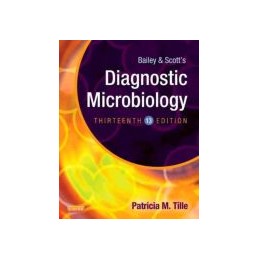- Obniżka


 Dostawa
Dostawa
Wybierz Paczkomat Inpost, Orlen Paczkę, DHL, DPD, Pocztę, email (dla ebooków). Kliknij po więcej
 Płatność
Płatność
Zapłać szybkim przelewem, kartą płatniczą lub za pobraniem. Kliknij po więcej szczegółów
 Zwroty
Zwroty
Jeżeli jesteś konsumentem możesz zwrócić towar w ciągu 14 dni*. Kliknij po więcej szczegółów
Opis
Part I: Basic Medical Microbiology
1. Microbial Taxonomy
2. Bacterial Genetics, Metabolism, and Structure
3. Host-Microorganism Interactions
Part II: General Principles in Clinical Microbiology
Section 1: Safety and Specimen Management
4. Laboratory Safety
5. Specimen Management
Section 2: Approaches to Diagnosis of Infectious Diseases
6. Role of Microscopy
7. Traditional Cultivation and Identification
8. Nucleic Acid-Based Analytic Methods for Microbial Identification and Characterization
9. Immunochemical Methods Used for Organism Detection
10. Serologic Diagnosis of Infectious Diseases
Section 3: Evaluation of Antimicrobial Activity
11. Principles of Antimicrobial Action & Resistance
12. Laboratory Methods and Strategies for Antimicrobial Susceptibility Testing
Part III: Bacteriology
Section 1: Principles of Identification
13. Overview of Bacterial Identification Methods and Strategies
Section 2: Catalase-Positive, Gram-Positive Cocci
14. Staphylococcus, Micrococcus, and Similar Organisms
Section 3: Catalase-Negative, Gram-Positive Cocci
15. Streptococcus, Enterococcus, and Similar Organisms
Section 4: Non-Branching, Catalase-Positive, Gram-Positive Bacilli
16. Bacillus and Similar Organisms
17. Listeria, Corynebacterium, and Similar Organisms
Section 5: Non-Branching, Catalase-Negative, Gram-Positive Bacilli
18. Erysipelothirix, Lactobacillus, and Similar Organisms
Section 6: Branching or Partially Acid-Fast, Gram-Positive Bacilli
19. Nocardia, Streptomyces, Rhodococcus, Oerskovia, and Similar Organisms
Section 7: Gram-Negative Bacilli and Coccobacilli (MacConkey-Positive, Oxidase-Negative)
20. Enterobacteriaceae
21. Acinetobacter, Stenotrophomonas, and Other Organisms
Section 8: Gram-Negative Bacilli and Coccobacilli (MacConkey-Positive, Oxidase-Positive)
22. Pseudomonas, Burkholderia, and Similar Organisms
23. Achromobacter, Rhizobium, Ochrobactrum, and Similar Organisms
24. Chryseobacterium, Sphingobacterium, and Similar Organisms
25. Alcaligenes, Bordetella (Nonpertussis), Comamonas, and Similar Organisms
26. Vibrio, Aeromonas, Plesiomonas shigelloides, and Chromobacterium violaceum
Section 9: Gram-Negative Bacilli and Coccobacilli (MacConkey-Negative, Oxidase-Positive)
27. Sphingomonas paucimobilis and Similar Organisms
28. Moraxella
29. Eikenella corrodens and Similar Organisms
30. Pasteurella and Similar Organisms
31. Actinobacillus, Kingella, Cardiobacterium, Capnocytophaga, and Similar Organisms
Section 10: Gram-Negative Bacilli and Coccobacilli (MacConkey-Negative, Oxidase-Variable)
32. Haemophilus
Section 11: Gram-Negative Bacilli that are Optimally Recovered on Special Media
33. Bartonella and Afipia
34. Campylobacter, Arcobacter, and Helicobacter
35. Legionella
36. Brucella
37. Bordetella pertussis and Bordetella parapertussis
38. Francisella
39. Streptobacillus moniliformis and Spirillum minus
Section 12: Gram-Negative Cocci
40. Neisseria and Moraxella catarrhalis
Section 13: Anaerobic Bacteriology
41. Overview and General Considerations
42. Laboratory Considerations
Section 14: Mycobacteria and Other Bacteria with Unusual Growth Requirements
43. Mycobacteria
44. Obligate Intracellular and Nonculturable Bacterial Agents
45. Cell Wall-Deficient Bacteria: Mycoplasma and Ureaplasma
46. The Spirochetes
Part IV: Parasitology
47. Overview of the Methods and Strategies in Parasitology NEW!
48. Intestinal Protozoa NEW!
49. Blood and Tissue Protoza NEW!
50. Protozoa from Other Body Sites NEW!
51. Intestinal Nematodes NEW!
52. Tissue Nematodes NEW!
53. Blood Nematodes NEW!
54. Intestinal Cestodes NEW!
55. Tissue Cestodes NEW!
56. Intestinal Trematodes NEW!
57. Liver and Lung Trematodes NEW!
58. Blood Trematodes NEW!
Part V: Mycology
59. Overview of Fungal Identification Methods and Strategies NEW!
60. Hyaline Molds, Zygomycetes, Dermatophytes, and Opportunitistic and Systemic Mycoses NEW!
61. Dematiaceious Molds NEW!
62. Opportunistic Atypical Fungus: P. jiroveci NEW!
63. The Yeasts NEW!
64. Antifungal Susceptibility Testing, Therapy and Prevention NEW!
Part VI: Virology
65. Overview of the Methods and Strategies in Virology NEW!
66. Viruses in Human Disease NEW!
67. Antiviral Therapy, Susceptibility Testing and Prevention NEW!
Part VII: Diagnosis by Organ System
68. Bloodstream Infections
69. Infections of the Lower Respiratory Tract
70. Upper Respiratory Tract Infections and Other Infections of the Oral Cavity and Neck
71. Meningitis and Other Infections of the Central Nervous Systems
72. Infections of the Eyes, Ears, and Sinuses
73. Infections of the Urinary Tract
74. Genital Tract Infections
75. Gastrointestinal Tract Infections
76. Skin, Soft Tissue, and Wound Infections
77. Normally Sterile Body Fluids, Bone and Bone Marrow, and Solid Tissues
Part VIII: Clinical Laboratory Management
78. Quality in the Clinical Microbiology Laboratory
79. Infection Control
80. Sentinel Laboratory Response to Bioterrorism
Glossary
